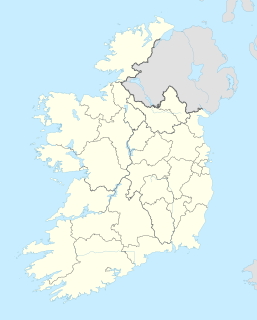
Sheep's Head, also known as Muntervary, is the headland at the end of the Sheep's Head peninsula situated between Bantry Bay and Dunmanus Bay in County Cork, Ireland.

Durrus is a village and civil parish in West Cork in Ireland. It is situated six miles (9.7 km) from Bantry in County Cork, at the head of the Sheep's Head and the Mizen Head peninsulas.

Carrigagulla is a megalithic complex 2.9 km north-east of Ballinagree, County Cork, Ireland.

Kealkill is a small village in County Cork, Ireland, located 10.3 kilometres from Bantry and 75.8 kilometres from Cork City. Its amenities include a church, a shop, a school, a community playgroup, two public houses and a GAA club.

The Seven Monuments is an embanked stone circle and National Monument located in County Galway, Ireland.

Tullycommon Wedge Tomb is a wedge-shaped gallery grave and National Monument located in The Burren region of County Clare, Ireland.

Coolcoulaghta Standing Stones is a pair of standing stones forming a stone row and National Monument located in County Cork, Ireland.

Derryarkane Stone Circle is an axial stone circle and National Monument located in County Cork, Ireland.

Clodagh Standing Stones is a pair of standing stones forming a stone row and National Monument located in County Cork, Ireland.

Breeny More Stone Circle is an axial stone circle and National Monument located in County Cork, Ireland.

Carrigaphooca Stone Circle is a stone circle and National Monument located in County Cork, Ireland.

Dunloe Ogham Stones is a collection of ogham stones forming a National Monument located in County Kerry, Ireland.

Loher Cashel is a stone ringfort (cashel) and National Monument located on the Iveragh Peninsula, Ireland.

The Beginish house is a stone house and National Monument associated with the Viking period, located in County Kerry, Ireland.

Beenbane is an ancient site and National Monument located in County Kerry, Ireland.

Kilcoolaght East Ogham Stones are a collection of ogham stones forming a National Monument located in County Kerry, Ireland.

Carrowcrom Wedge Tomb is a wedge-shaped gallery grave and National Monument located in County Mayo, Ireland.

An axial stone circle is a megalithic ring of stones of a particular design found in County Cork and County Kerry in southwest Ireland. Archaeologists have found it convenient to consider the axial five-stone circle and axial multiple-stone circle separately. The circle has an approximate axis of symmetry aligned in a generally northeast–southwest direction. The stone at the southwest side of the circle, rather than being an upright orthostat like all the rest, is a slab lying horizontally with its long thin edge along the circumference of the ring. Because it marks the axis of the circle it is called the axial stone.









